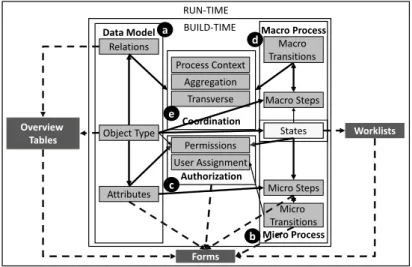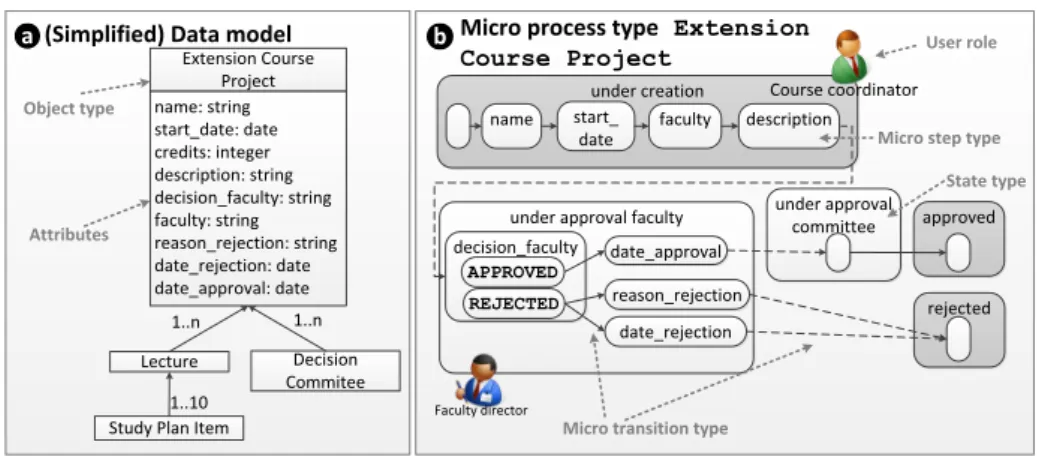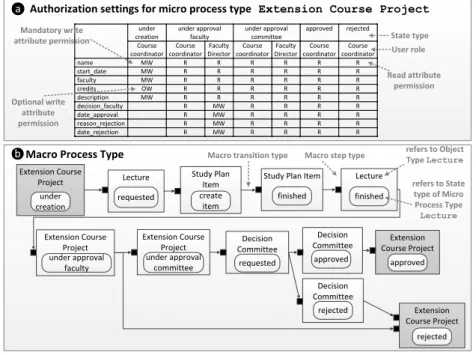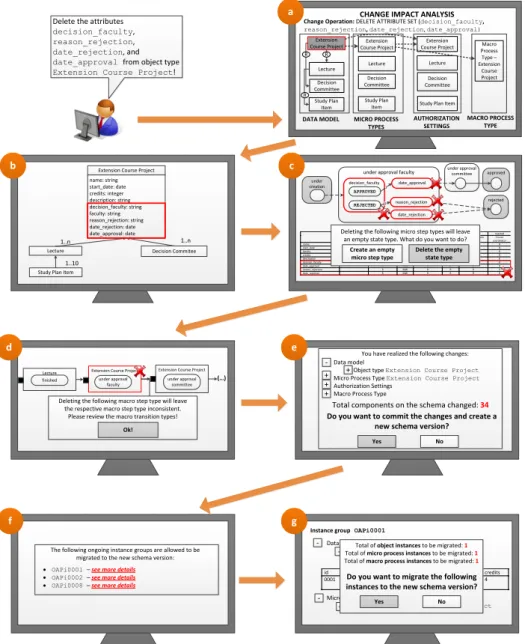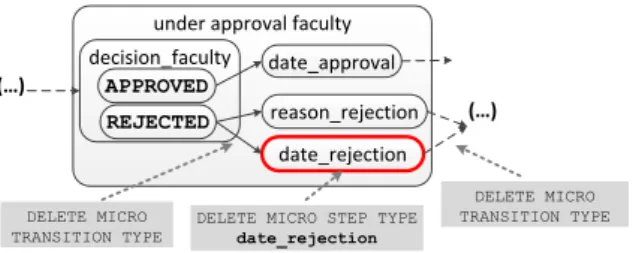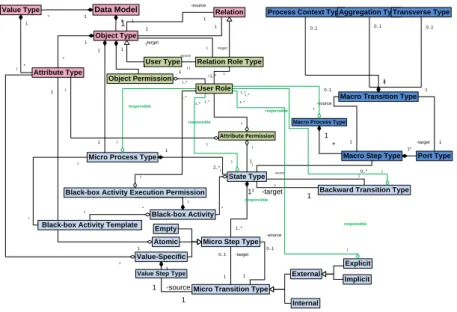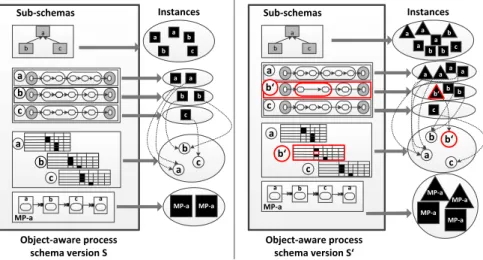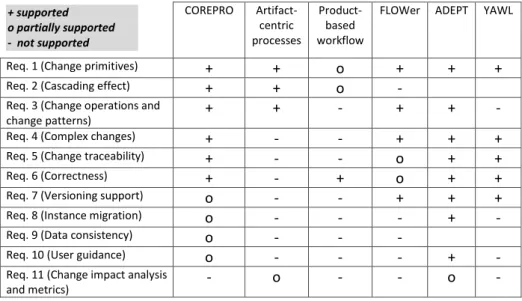Towards Schema Evolution in
Object-aware Process Management Systems
Carolina Ming Chiao, Vera K¨unzle, Manfred Reichert Institute of Databases and Information Systems
University of Ulm, Germany
{carolina.chiao, vera.kuenzle, manfred.reichert}@uni-ulm.de Abstract:Enterprises want to improve the lifecycle support for their businesses pro- cesses by modeling, enacting and monitoring them based on process management sys- tems (PrMS). Since business processes tend to change over time, process evolution support is needed. While process evolution is well understood in traditional activity- centric PrMS, it has been neglected inobject-awarePrMS so far. Due to the tight in- tegration of processes and data, in particular, changes of the data and process schemes must be handled in an integrated way; i.e., the evolution of the data schema might affect the process schema and vice versa. This paper presents our overall vision on the controlled evolution of object-aware processes. Further, it discusses fundamental requirements for enabling the evolution of object-aware process schemas in PHILhar- monicFlows, a framework targeting at comprehensive support of object-aware pro- cesses.
1 Introduction
Aiming at improved process lifecycle support, a decade ago, many researchers started working on process schema evolution. In general, business processes may evolve for sev- eral reasons; e.g, due to changes in the business, technological environment, or legal con- text [RW12]. Consequently, business process changes need to be rapidly mapped to the process-aware information system (PAIS) implementing these processes.
Activity-centric process management systems (PrMS) like YAWL [vdAtH05] and ADEPT [RD98, RRD04, RW12] already provide comprehensive process lifecycle support, includ- ing the controlled evolution of business processes. Regarding object-aware processes [K¨un13], however, this does not apply yet. Due to the tighter integration of process and data, changes of the data and process schemes must be handled in an integrated way. In other words, changing the data schema may affect the schema of an object-aware process and vice versa. Note that respective dependencies might become complex when taking different levels of process granularity as well as authorization constraints into account as well.
The example below is based on a real educational scenario. It comprises a process for managing extension course projects. Extension courses target at professionals that want to refresh and update their knowledge in a certain area. In order to propose a new extension course, the course coordinator must create a corresponding project description. The latter must then be approved by the faculty coordinator and the extension course committee.
Example 1 (Object-aware Process: Extension course proposal). The course
coordinatorcreates an extension course project using a form. In this context, he must provide details about the course, likename, start date and description. Fol- lowing this, professors may start creating the lectures of the extension course. In turn, eachlecturecomprisesstudy plan items, which describe the topics to be cov- ered by the lecture. After creating the lectures, thecoordinatormay request an approval of theextension course project. First, an approval must be provided by thefaculty director. If he wants torejectthe proposal, the extension course must not take place.
Otherwise, the project is sent to the extension course committee, which will evalu- ate it. If there are morerejectionsthanapprovals, theextension course projectis
rejected. Otherwise, it isapprovedand hence may take place in future.
The process from Example 1 can be characterized by its need forobject-awareness; i.e., business processes and business objects must not be treated independently from each other.
In general,object-aware processesshow three major characteristics. First, they are based ontwo levels of granularity. On the one hand, thebehaviorof individual object instances needs to be considered during process execution; on the other, theinteractions among different object instances must be taken into account. Second, process execution isdata- driven; i.e., the progress of a process depends on available object instances as well as the values of their attributes. Third,flexible activity executionis crucial. In particular, activities need not always coincide with process steps.
The PHILharmonicFlows framework we are developing targets at a comprehensive support of object-aware processes [KR09b, KR09a, KR11, K¨un13]. It comprises modules for the modeling, execution and monitoring of object-aware processes. In this framework,object behavioris captured throughmicro processes. In turn,object interactionsare captured by a macro process. Furthermore, data is modeled separately from micro and macro processes.
Note that each of these models comprises differentcomponents. For example, a data model comprises object types as well as their attributes and relations to other object types.
Schema evolutionhas neither been considered by PHILharmonicFlows nor other frame- works for artifact-based or object-aware processes yet. As a major challenge, one must cope with the complex interdependencies that exist between the models and components (e.g., data model, object types, attributes, or micro process types) of the framework;
i.e., changing one component (e.g., deleting an object attribute) may require concomitant changes of other components (e.g., changing the behavior of the object type). Moreover, changes must be handled at both the static and dynamic (i.e., instance) level. Changing an object-aware process without any user assistance will be error-prone and time-consuming.
Therefore, user interactions should be properly supported in order to guide the modeler when changing an object-aware process. In particular, any guidance must hide complexity from users, taking correctness constraints and component dependencies into account.
This paper presents requirements necessary to enable schema evolution for object-aware processes. To illustrate how these requirements were derived, we sketch our vision on how the user should interact with the PHILharmonicFlows tool when changing an object- aware process. Sect. 2 provides an overview of the PHILharmonicFlows framework. Sect.
3 presents research questions to emphasize the scope of our work. In Sect. 4, we introduce
our vision on how the user (i.e., modeler) should be supported when evolving object-aware processes. Sect. 5 presents major requirements emerging in this context. Sect. 6 discusses the related work and Sect. 7 gives a summary and outlook.
2 The PHILharmonicFlows Framework
The PHILharmonicFlows framework enforces a modeling methodology governing the object-centric specification of business processes based on a well-defined formal semantics [KR11, K¨un13]. In general, anobject-aware process schemacomprises the following sub- schemas: data model (cf. Fig. 1a), micro process types (cf. Fig. 1b), macro process types (cf. Fig. 1d), and authorization settings (cf. Fig. 1c). In turn, each sub-schema comprises a set of components (e.g., a data model comprises object types, object type attributes and relations to other object types), which may be related to components of other sub-schemas (e.g., a micro step type depends on an attribute of an object type). When changing compo- nents, hence, concomitant changes of dependent components become necessary as well.
RUN-TIME BUILD-TIME Data Model
Micro Process Macro Process
Object Type States
Micro Steps Micro Transitions Macro Steps
Macro Transitions Relations
Attributes
Coordination Overview
Tables Worklists
Forms Authorization Process Context
Aggregation Transverse
Permissions User Assignment a
b d
c e
Figure 1: The PHILharmonicFlows framework
As a fundamental prerequisite, object types and their relations need to be captured in adata model(cf. Fig. 1a). Furthermore, for eachobject type, a correspondingmicro process type needs to be specified (cf. Fig. 1b). The latter defines the behavior of related object in- stances, and consists of a set ofmicro stepsas well as thetransitionsbetween them. In turn, each micro step is associated with anobject type attribute. Further, micro steps are grouped in objectstates. At run-time, for eachobject instance, a correspondingmicro process instanceis created. A micro process instance being in a particular state may only proceed if specific values are assigned to the object instance attributes associated with this state; i.e.,data-driven process executionis enabled. In addition,optional data accessis ac- complished asynchronously to micro process execution based on the permissions granted for reading or writing object attributes. In this context, access rights for an object instance depend on the progress of the corresponding micro process instance as well. Altogether,
the framework maintains anauthorization tableassigning data permissions to user roles which may also depend on the respective state of the micro process type (cf. Fig. 1c).
Extension Course Project name: string start_date: date credits: integer description: string decision_faculty: string faculty: string reason_rejection: string date_rejection: date date_approval: date
Study Plan Item
Decision Commitee Lecture
1..n 1..n
1..10
a(Simplified) Data model b Micro process type Extension Course Project
under creation name start_
date faculty
under approval faculty decision_faculty date_approval
reason_rejection date_rejection APPROVED
REJECTED
under approval committee approved
rejected Course coordinator
Faculty director Object type
Attributes
State type User role
Micro transition type
description
Micro step type
Figure 2: Data model and micro process type modeled with PHILharmonicFlows Taking the relations between the object instances of the overalldata structure (i.e., the instance of a data model) into account, the corresponding micro process instances form a complexprocess structure; i.e., their execution needs to be coordinated according to the given data structure. In PHILharmonicFlows, this is accomplished by means of macro processes. Amacro process typeconsists ofmacro stepslinked bymacro transitions(cf.
Fig. 1d). Opposed to micro steps, which refer to single attributes of a particular object type, a macro step refers to a particular state of an object type. In addition, for each macro transition, a coordination component must be specified (cf. Fig. 1e). The latter hides the complexity of large process structures from modelers as well as end-users. More precisely, such a coordination component coordinates the interactions among the object instances of the same type as well as different types. Opposed to existing approaches, the semantic relations between the object instances and their cardinalities are also taken into account.
Figs. 2 and 3 show how Example 1 can be modeled based on PHILharmonicFlows. Micro process type Extension course project is derived from the object type having same name (cf. Figs. 2a+b). In this micro process type, thecourse coordinatormust write attributesname,start date,faculty, anddescription. Note that this configuration needs to be reflected in the authorization settings (cf. Fig. 3a). Furthermore, attributecredits
may beoptionallywritten. In turn, a macro process type (cf. Fig. 3b) is composed of macro step types. The latter reference state types from the micro process types. For example, macro step typeExtension Course Project - under creationrefers to state typeunder creationof micro process typeExtension Course Project(cf. Fig. 2b).
3 Research Questions
To emphasize the scope of our problem, we consider the following research questions:
Research Question 1 (RQ1): How to change an object-aware process schema without violating correctness neither of the modified component itself nor any dependent compo-
a Authorization settings for micro process type Extension Course Project
Extension Course Project
under creation
Lecture requested
Study Plan Item create
item
Study Plan Item finished
Lecture finished
Extension Course Project under approval
faculty
Extension Course Project under approval
committee
Decision Committee
requested
Decision Committee approved
Decision Committee
rejected
Extension Course Project
approved
Extension Course Project
rejected
bMacro Process Type
under creation
under approval faculty
under approval committee
approved rejected Course
coordinator Course coordinator
Faculty Director
Course coordinator
Faculty Director
Course coordinator
Course coordinator
name MW R R R R R R
start_date MW R R R R R R
faculty MW R R R R R R
credits OW R R R R R R
description MW R R R R R R
decision_faculty R MW R R R R
date_approval R MW R R R R
reason_rejection R MW R R R R
date_rejection R MW R R R R
Macro step type Macro transition type
Read attribute permission User role State type Mandatory write
attribute permission
Optional write attribute permission
refers to Object Type Lecture
refers to State type of Micro Process Type Lecture
Figure 3: Authorization settings and macro process type modeled with PHILharmonicFlows nents?
Research Question 2 (RQ2):How to handle active instances (i.e., object and micro pro- cess instances) when evolving the object-aware process schema?
Research Question 3 (RQ3): How to assist users in evolving an object-aware process schema?
RQ1 refers to changes at the static level. It deals with structural changes of an object-aware process schema; i.e., its sub-schemas and their components. In turn, RQ2 addresses issues related to dynamic changes; i.e., managing different schema versions and adopting the best policy to migrate active instances to the new schema version. Finally, RQ3 deals with user issues, such as providing user guidance while hiding the complexity of schema changes from them. These research questions guide our vision discussed in Sect. 4. Further, they serve as starting point for eliciting requirements related to the evolution of object-aware processes.
4 Overall Vision
To illustrate the scope of our research, we define a number of scenarios (i.e., user stories) dealing with schema changes of our sample process. While some scenarios are rather simple, not requiring any concomitant change, others are more complex involving several schemas of the object-aware process. Thereby, a major challenge concerns user interaction as changing an object-aware process schema constitutes an error-prone and complex task.
Hence, user guidance is required to assist users when changing the schema of an object- aware process, e.g., by indicating the components affected by an intended change. For
Delete the attributes decision_faculty, reason_rejection, date_rejection, and date_approval from object type Extension Course Project!
Extension Course Project name: string start_date: date credits: integer description: string decision_faculty: string faculty: string reason_rejection: string date_rejection: date date_approval: date
Decision Commitee Lecture
1..n 1..n
under creation
under approval faculty decision_faculty date_approval
reason_rejection date_rejection 3
1 APPROVED REJECTED 2
under approval committee approved
rejected
under creation under approval faculty under approval committee approved rejected
Course coordinator Course coordinator Faculty Director Course coordinator Faculty
Director Course coordinator Course coordinator
name MW R R R R R R
start_date MW R R R R R R
faculty MW R R R R R R
credits MW R R R R R R
description MW R R R R R R
decision_faculty R MW R R R R
date_approval R MW R R R R
reason_rejection R MW R R R R
date_rejection R MW R R R R
Study Plan Item 1..10
Create an empty micro step type
Deleting the following micro step types will leave an empty state type. What do you want to do?
Delete the empty state type
Lecture finished
Extension Course Project under approval
faculty
Extension Course Project under approval
committee (…)
(…) Deleting the following macro step type will leave the respective macro step type inconsistent.
Please review the macro transition types!
Ok!
(…) You have realized the following changes:
Yes Data model
Object type Extension Course Project Micro Process Type Extension Course Project Authorization Settings
Macro Process Type
Total components on the schema changed: 34 +
- + +
Do you want to commit the changes and create a new schema version?
No +
b c
d e
f
(…) The following ongoing instance groups are allowed to be
migrated to the new schema version:
· OAPi0001 – see more details
· OAPi0002 – see more details
· OAPi0008 – see more details
g
Instance group OAPi0001 Data model
Object type Extension Course Project
Micro process
Micro process type Extension Course Project -
-
+ -
id name start_date faculty credits
0001 Creative writing
20/06/2015 English 4
Total of object instances to be migrated: 1 Total of micro process instances to be migrated: 1 Total of macro process instances to be migrated: 1
Yes
Do you want to migrate the following instances to the new schema version?
No
a CHANGE IMPACT ANALYSIS
Change Operation: DELETE ATTRIBUTE SET (decision_faculty, reason_rejection, date_rejection, date_approval)
DATA MODEL MICRO PROCESS TYPES
AUTHORIZATION SETTINGS
MACRO PROCESS TYPE Extension
Course Project
Lecture Decision Committee Study Plan Item R
R R
Extension Course Project
Lecture Decision Committee Study Plan Item
Extension Course Project
Lecture Decision Committee
Study Plan Item Macro Process Type – Extension
Course Project
Figure 4: Sketch of end-user guidance for object-aware process schema changing
illustration purpose, we provide a mockup showing how to guide a user in the context of a concrete change scenario.
Change scenario (SC):The extension course projectneeds not be approved by the
faculty directoranymore, and the overall schema shall be adapted accordingly.
Since for an extension course project the approval of the faculty director is no longer needed, the user wants to delete the attributes referring to it (e.g., decision faculty,
reason rejection,date rejection, anddate approval); i.e., he wants to change the data model. In turn, this requires concomitant schema adaptations. First of all, the user should be notified about the effects of the change; i.e., achange impact analysisis required. Based on such an analysis, it can be visualized which sub-schemas and components are affected by the change and how they are related. Regarding our mockup (cf. Fig. 4a), the object- aware process schema is divided into four levels corresponding to the sub-schemas data model, micro process types, authorization settings, and macro process type. The dotted arrows represent potential effects caused by the change. In the given scenario, changing object typeExtension Course Projectaffects the corresponding micro process type as well as the authorization settings. Changing the micro process typeExtension Course Project, in turn, may further affect the macro process type.
Being aware of the possible effects of the intended change, the user may then be guided in performing required concomitant changes (cf. Fig. 4b). According to PHILharmon- icFlows (cf. Sect. 2), micro steps of a particular micro process are directly related to the attributes of the corresponding object type. Therefore, when an attribute is deleted, the corresponding micro step type needs to be deleted as well. In Fig. 4c, in turn, the deletion of the respective micro step types will result in an “empty” state type. According to the correctness constraints of the framework, this is not possible, and would leave the micro process type in an inconsistent state. Therefore, the user should be notified about this problem and guided in resolving it. In Fig. 4d, the user decides to delete the entire state type, which, in turn, causes another inconsistency in the macro process type. Again, the user should be notified about this, enabling him to redefine the macro transition types that link the respective macro step type. In general, every time the user changes a component, respective correctness checks should be performed automatically in order to be able to guide the user in resolving potential inconsistencies.
Since changes of one component might trigger changes of others, the user will not al- ways be aware of the number of components actually changed. Hence, after guiding him through required adaptations of the object-aware process, an overview of all components to be changed should be provided; e.g., such overview could present information about the components to be changed as well as quantitative metrics (e.g., number of components and models to be changed) (cf. Fig. 4e). Finally, the user should explicitly commit the changes, resulting in a new version of the object-aware process schema.
In addition to structural adaptations and structural consistency, active instances must be taken into account; i.e., it should be possible to adapt the running instances according to the changed object-aware process schema. Fig. 4f presents the active instances that may be migrated to the new schema version without causing any run-time error. To foster
visualization, instances are grouped according to the underlying object type; i.e., each instance group refers to one particular object type. In our example, the instances refer to anextension course project. Then, the user may choose which group of instances he wants to migrate. Further, he may retrieve more detailed information about the respective instances (cf. Fig. 4g). Finally, like in the context of model changes, the user will get an overview of the instances to be migrated.
5 Requirements
Based on our research questions, the sketched vision, and an extensive literature study, we derived major requirements. The requirements of Sect. 5.1 are related to RQ1, while the ones of Sect. 5.2 are related to RQ2. Finally, the requirements of Sect. 5.3 are related to user guidance issues (i.e., RQ3).
5.1 Structural Changes at the Static Level
Requirement 1 (Change primitives).To accomplish structural adaptations of an object- aware process schema, change primitives are required to directly operate on single schema elements. In our context, such primitives denote atomic operations likeadd attribute type, delete micro step type, and add state type. In general, the set of available change primitives should becompleteandminimal[CCPP98, RD98, RW12]. Complete- ness means that the available set of change primitives shall allow transforming any object- aware process schemaSinto any other object-aware process schemaS’. In addition, the core set of provided change primitives should be minimal; i.e., it should not contain any primitive that can be simulated through the combination of other primitives. Finally, for each change primitive, a precise definition of parameters, pre-conditions, and post- conditions (i.e., effects) is required [CCPP98].
Example 2 (Requirement 1: Change primitives). For removing micro step type
date rejectionof state typeunder approval faculty, change primitives for deleting the micro step type and its related micro transition types are required (cf. Fig. 5).
under approval faculty decision_faculty date_approval
reason_rejection date_rejection APPROVED
REJECTED (…)
DELETE MICRO STEP TYPE date_rejection DELETE MICRO
TRANSITION TYPE
DELETE MICRO TRANSITION TYPE (…)
Figure 5: Example of change primitives
Requirement 2 (Cascading effects). Fig. 6 presents the meta model of PHIlharmon- icFlows, expressed in terms of an UML class diagram. The dependencies between the different components of the framework are represented as bidirectional associations, com- positions and aggregations. Regarding the class diagram, thebidirectional association
represents components linked with each other in the context of a particular model (e.g., micro step types are linked with micro transition types within a micro process type). A composition dependencyindicates a “strong” association between components, making one component (i.e., parent component) responsible for the creation and destruction of other components (i.e., child components). For example, an object type is strongly as- sociated with attribute types. If the object type is deleted, all related attributes must be deleted as well. In turn, theaggregation dependencyconstitutes a “weaker” relationship between components: even when deleting the parent component, the child components will not be removed. An example of an aggregation dependency is provided by the re- lationship between the micro step types and attributes. If a micro step type is deleted, the associated attribute is preserved. Due to these dependencies and associations among different components of the framework, changing one of them might require changes of dependent components as well. In turn, such concomitant changes might again trigger ad- ditional changes on other components (i.e., acascadingchange). In general, mechanisms are required to detect necessary concomitant changes and to guide the user in applying them.
Data Model
Object Type
*1 Value Type
User Type
* 1
Attribute Type
* 1
*
1 1
-source
1 1
-target 1
Micro Process Type
1
1
State Type
2..*
1
Micro Step Type
1..*
1 1
1
-source
0..1
1 -target 0..1
1 External
Implicit Explicit Empty
Atomic Value-Specific Value Step Type
* 1
Macro Step Type
0..*
1
Macro Process Type
* 1
Port Type
* 1
-source 1
1
Macro Transition Type
-source 0..1
1 -target 1
1
Process Context Type
1 0..1
1 0..1
1 0..1
1..*
1 1 1
1..*
1 1
1
1 1 1..*
1 responsible 1
1
Backward Transition Type
-source 1
1
-target
1 1
1..*
1 responsible 1..*
1 responsible
1..*
1
responsible 1..*
responsible 1
Relation Role Type
1 -source 1 1
-target 1
Internal
1
* 1
1..*
* 1
1 *
* 1
1
Black-box Activity Execution Permission1..*
Black-box Activity Template
Black-box Activity Object Permission
User Role
Micro Transition Type Attribute Permission
Aggregation TypeTransverse Type Relation
Figure 6: PHILharmonicFlows meta-model
Requirement 3 (Change operations and change patterns). Realizing structural adap- tations based on change primitives might introduce errors and inconsistencies. Usually, at such a low level of abstraction, the combined application of several change primitives is required to ensure schema correctness. As an alternative, high-level change operations may be used; e.g., it should be possible to move an entire state type within a micro pro- cess type based on a single change operation. Like change primitives, high-level change operations should have pre-conditions. Generally, empirically-grounded change patterns should be defined, which capture the semantics of frequent changes, thus raising the level
of abstraction [WRRM08, RW12].
Example 3 (Requirement 3: Change operations). Deleting state typeunder approval faculty(cf. Fig. 5) requires deleting all micro step types associated with this state type as well (i.e.,decision faculty,date approval,reason rejection, anddate rejection).
Further, this deletion includes the micro transition types linking the micro steps and the authorization settings of state typeunder approval faculty. In this context, a change operation allowing for the deletion of the entire state type together with its components would facilitate change definition significantly, and hence reduce errors and inconsisten- cies of the object-aware process schema.
Requirement 4 (Complex changes).When adapting an object-aware process schema, the integrity and consistency of the various sub-schemas must be preserved; i.e., the changes applied to the sub-schemas will only be applied if this does not result in any inconsis- tency. Like for database transactions, the changes applied jointly to an object-aware pro- cess schema must be treated atomically (i.e., as transaction). Accordingly, modelers must explicitlycommitcomplex changes. Finally, multiple users may want to change the same schema version at the same time, requiring properconcurrency control.
Requirement 5 (Change traceability). When changing an object-aware process, infor- mation onwhoappliedwhichchanges,whenandwhyshall be recorded in logs; i.e., change traceability needs to be ensured.
Requirement 6 (Correctness).Changing an object-aware process schema must not result in errors in any of the sub-schemas and not lead to soundness violations (e.g., deadlocks due to data inconsistencies or missing data at run-time). Moreover, a changed object- aware process schema must comply with the correctness criteria established in [K¨un13].
Correctness checks are required at two different stages. First, when specifying the various changes of an object-aware process schema, correctness checks are “soft”; i.e., they pro- vide basis to inform the modeler about potential inconsistencies or missing components.
Second, correctness needs to be ensured when committing a change transaction; i.e., all sub-schemas forming an object-aware process schema must be correct.
5.2 Changing Active Instances at the Dynamic Level
Requirement 7 (Versioning support). Active instances whose processing started before the schema change must be properly handled. One strategy frequently applied in the con- text of database and process evolution, isschema versioning[Rod96, GdSEM05, KG99].
Every time a schema is changed, a new schema version is created; already active instances continue their processing based on the old schema version. In our context, there are various sub-schemas forming the overall object-aware process schema (i.e., data model, micro and macro process schemas, and authorization settings). Hence, for each object-aware process schema version, the versions of its sub-schemas need to be maintained (cf. Fig. 7). In particular, the instances are linked to a sub-schema version as well as the object-aware process schema version.
If a change is performed, which concerns only a part of the entire object-aware process schema, creating a new version of all sub-schemas involved (even the unchanged ones) will
Object-aware process schema version S‘
a
b c
a b c a
Sub-schemas Instances
a b
a c b
a a
b b
c
MP-a MP-a
MP-a
a
b c
Sub-schemas Instances
a a b
a a b‘
MP-a MP-a
a b c a
b
c a
b
c a
b‘
c a
b‘
c a
b‘
c
a b c a
MP-a
Object-aware process schema version S
a a b b c
a a b b c
b
MP-a MP-a
Figure 7: Object-aware process schema versions
not be optimal. Hence, a new version of an object-aware process schema shall comprise the new versions of the changed sub-schemas in combination with the versions of the unchanged sub-schemas. Fig. 7 illustrates this concept. The object-aware process schema
Son the left side contains a data model with object typesA,BandC. Each object type is associated with a micro process type as well as authorization settings. The latter express who may access which attributes at which stages during process execution. Finally, macro process typeMP-adescribes the interaction of the object types. The small squares represent the instances created according object-aware process schema versionSand being active at the moment. On the right side, a new versionS’ofSis depicted; it resulted due to a change of micro process typeb. The latter led to a new versionb’ofband a change of related authorization settings. Instead of generating copies for all sub-schemas,S’comprises the new versionb’, the new version of the respective authorization settings, and references to the versions of the unchanged sub-schemas. New instances run according to the new schema versionS’, while the older, but still active instances continue running on the old schema versionS; i.e., instances running on the two schema versions will co-exist. In Fig.
7, new instances are represented as triangles and old ones as squares.
Requirement 8 (Instance migration).To ensure that active instances may continue run- ning on the old schema version is not sufficient. In addition, it shall be possible to re- assign active instances to the new object-aware process schema version if desired. Like in activity-centric PrMS [CCPP98, JH98, RD98, RRMD09], such migration of active in- stances must be handled in a controlled manner. In general, not all instances can be mi- grated to the new schema version, particularly if they have progressed too much in their execution. Since there may be numerous concurrently running instances of an object- aware process (i.e., object and micro process instances), the selection of the migratable instances should not handle the instances individually. In the example from Fig. 8a, a new state is inserted in micro process typeA. Moreover, the progress of the instances of micro processBnow depends on the execution of micro processA; i.e., the instances ofBwill only reach states5 if all instances ofA’reach states7 (cf. Fig. 8b). However, not all
active instances of micro processAcan be migrated toA’. More precisely, micro process instancesA1andA2have already completed their executions, which means that they can- not be migrated toA’. In turn, micro process instanceA3may be migrated. However, the individual migration ofA3will cause adeadlockat run-time, since micro process instance
B1will continue waiting for instancesA1andA2to reach states7. Therefore, a group of instances associated to a particular changed component must not be migrated individually.
Micro Process A (before change) Object-aware process schema S‘
Object-aware process schema S
Micro Process Type B
s4 s5 s6
s1 s2 s7 s3
Micro Process Type A‘
Micro Process Type A
s1 s2
s7 s3
Micro Process Type B
s4 s5 s6
s1 s2 s3
instance A1
instance A2 s1 s2 s3
s1 s2 s3
instance A3
a b c
Micro Process B
instance B1 s4 s5 s6
d
Figure 8: Example of instance migration
Requirement 9 (Data consistency).One of the biggest issues concerning database schema evolution is to prevent data loss when changing a database schema [Ra04]; i.e., the deletion of object types or attributes must not delete the data associated to them, since there may be software systems that still depend on this data. In the context of object-aware processes, data inconsistency might cause run-time errors (e.g., deadlocks). Therefore, it becomes necessary to prevent data inconsistencies (e.g., data loss or missing data important to the logic of the process) relevant for process execution.
5.3 User Requirements
Requirement 10 (User guidance). Changing an object-aware process schema is a non- trivial task from the viewpoint of the user (i.e., process modeler). Our experiences with the change scenarios have shown that user guidance is required to hide this complexity and hence to make schema changes more intuitive and less error-prone (cf. Sect. 4). Moreover, user guidance not only eases the adaptation of an existing schema, but also the modeling of new object-aware process schemas.
Requirement 11 (Change impact analysis and metrics).To better control potential costs of a change, achange impact analysisshould be performedbeforeactually applying the change. Such an analysis must consider the cascading effects; i.e., it must show to users which components are going to be affected by the change. Moreover, metrics help users to evaluate change complexity.
6 Related Work
The described requirements have been partially addressed by existing work. Fig. 9 sum- marizes which requirements have been addressed by which approach. We investigated data-centric approaches and traditional activity-centric ones.
Data-centric Approaches
Data-driven Process Coordination (COREPRO) [MRH07, MRH08] presents a set of change primitives and operations to change both data and process structures. Since the latter are directly related, the approach automatically adapts the process structure when chang-
COREPRO Artifact- centric processes
Product- based workflow
FLOWer ADEPT YAWL
Req. 1 (Change primitives) + + o + + +
Req. 2 (Cascading effect) + + o -
Req. 3 (Change operations and
change patterns) + + - + + -
Req. 4 (Complex changes) + - - + + +
Req. 5 (Change traceability) + - - o + +
Req. 6 (Correctness) + - + o + +
Req. 7 (Versioning support) o - - + + +
Req. 8 (Instance migration) o - - - + -
Req. 9 (Data consistency) o - - -
Req. 10 (User guidance) o - - - + -
Req. 11 (Change impact analysis
and metrics) - o - - o -
+ supported o partially supported - not supported
Figure 9: Evaluation of different approaches
ing the corresponding data structure. Moreover, it enables change traceability as well as change transactions. Correctness is ensured when changing the structures at static or in- stance level. In case of inconsistencies, the modeler is notified accordingly. However, even though the data objects are explicitly represented, the control of the data structures is still realized outside the scope of the PrMS. Hence, versioning support and instance migration is only available for the process structures.
Regarding artifact-centric processes, [WW14] proposes an approach for dealing with the change impact analysis of three-level artifact-centric business processes (ACBP). The au- thors first classify the types of changes that may be applied to an ACBP. This classification provides the basis for the change analysis. For this analysis, a graph representing the different element dependencies is created. Based on this graph, it becomes possible to calculate the direct impact of a change. The approach, however, just covers the changes at static level, without addressing the problems of complex changes and traceability. In turn, [XSY+11] allows for ad-hoc changes on the artifacts’ life cycles. Such changes are based rules and declarative constructs such asskip,addandreplaceand are applied to the tasks.
The artifacts, in turn, cannot be changed. Besides, the authors do not provide information on how the active instances should be handled when a change is applied.
In the context of product-based workflows, [RVV10] presents four change primitives en- abling changes of the product (i.e., data) structure. These are then reflected in the corre- sponding process models without need for any manual adaptation. Changes at the process level, however, are not considered. Moreover, information regarding change traceability and run-time issues are neglected.
The case-handling system FLOWer [vdAWG05, MWR08] does not address cascading ef- fects; i.e., inconsistencies in a dependent component caused by a change are not properly handled by the system. Moreover, the system does not use formal correctness criteria in
the context of schema evolution [WRRM08]. Regarding schema versioning, FLOWer al- lows for overwriting a process schema as well as for the co-existence of instance running on different schema versions. Instance migration is not considered.
Activity-centric Approaches
In activity-centric approaches, the processes are described on a single level (i.e., the pro- cess model). Additionally, data is managed outside the scope of the PrMS. For these reasons, requirements regarding cascading effects (Req. 2) and data consistency (Req. 9) were not addressed to the analyzed approaches. ADEPT [RD98, RRD04, RW12] is an activity-centric PrMS that enables both schema evolution and ad hoc changes of single process instances. Moreover, it focuses on theease of useof its process support features.
Additionally, metrics regarding instance migration are provided. In turn, YAWL supports evolutionary changes in workflows based on Worklets [vdAtH05]. The latter refer to an extensive repertoire of self-contained sub-processes and association rules, which can be inserted into the process model without any system downtime. Even though it provides primitives for changing the process model, there are no change patterns or operations to realize changes at a higher abstraction level. Regarding the user, no guidance or change impact analysis are provided.
7 Summary and Outlook
Our overall vision is to enable schema evolution in object-aware processes. The major challenge lies on the very tight integration of the components of the framework. Such component dependencies might not only affect the object-aware process schema at static level, but active instances as well; i.e., new versions of a particular sub-schema must co- exist with unchanged versions of other sub-schemas. Moreover, we observed that user guidance is crucial to hide the complexity from the modeler and to avoid schema errors.
In future work, we will provide detailed insights into our solution tackling the discussed requirements.
References
[CCPP98] F. Casati, S. Ceri, B. Pernici, and G. Pozzi. Workflow Evolution. Data & Know Eng, 24(3):211–238, 1998.
[GdSEM05] R. Galante, C. Saraiva dos Santos, N. Edelweiss, and A. F. Moreira. Temporal and Versioning Modeling for Schema Evolution in Object-oriented Databases. Data &
Know Eng, 53(2):99–128, 2005.
[JH98] G. Joeris and O. Herzog. Managing Evolving Workflow Specifications. In Proc.CoopIS’98, pages 310–319, 1998.
[KG99] M. Kradolfer and A. Geppert. Dynamic Workflow Schema Evolution Based on Work- flow Type Versioning and Workflow Migration. InProc. CoopIS’99, pages 104–114, 1999.
[KR09a] V. K¨unzle and M. Reichert. Integrating Users in Object-aware Process Management Systems: Issues and Challenges. InProc. BPM’09 Workshops, pages 29–41, 2009.
[KR09b] V. K¨unzle and M. Reichert. Towards Object-aware Process Management Systems:
Issues, Challenges, Benefits. InProc. BPMDS’09, pages 197–210, 2009.
[KR11] V. K¨unzle and M. Reichert. PHILharmonicFlows: Towards a Framework for Object- aware Process Management. Journal of Software Mainteinance and Evolution: Re- search and Practice, 23(4):205–244, 2011.
[K¨un13] V. K¨unzle.Object-aware Process Management. PhD thesis, Ulm University, 2013.
[MRH07] D. M¨uller, M. Reichert, and J. Herbst. Data-driven Modeling and Coordination of Large Process Structure. InProc. CoopIS’07, pages 131–149, 2007.
[MRH08] D. M¨uller, M. Reichert, and J. Herbst. A New Paradigm for the Enactment and Dy- namic Adaptation of Data-driven Process Structures. InProc. CAiSE’08, pages 48–63, 2008.
[MWR08] B. Mutschler, B. Weber, and M. Reichert. Workflow Management versus Case Han- dling: results from a Controlled Software Experiment. InProc. SAC’08, pages 82–89, 2008.
[Ra04] Y.-G. Ra. Relational Schema Evolution for Program Independency. InProc. CIT 2004, volume 3356, pages 273–281, 2004.
[RD98] M. Reichert and P. Dadam. ADEPTflex - Supporting Dynamic Changes of Workflows Without Losing Control. Journal of Intelligent Information Systems, 10(2):93–129, 1998.
[Rod96] J. F. Roddick. A Model for Schema Versioning in Temporal Database Systems. Aus- tralian Computer Science Communications, 18:446–452, 1996.
[RRD04] S. Rinderle, M. Reichert, and P. Dadam. Flexible Support of Team Processes by Adap- tive Workflow Systems.Distr. Parallel Databases, 16(1):91–116, 2004.
[RRMD09] M. Reichert, S. Rinderle-Ma, and P. Dadam. Flexibility in Process-Aware Information Systems.Trans Petri Nets and other Models of Conc III, pages 115–135, 2009.
[RVV10] H. A. Reijers, J. Vogelaar, and I. Vanderfeesten. Changing Products, Changing Pro- cesses: Dealing with Small Updates in Product-Based Design. InProc. eKNOW’10, pages 56–61, 2010.
[RW12] M. Reichert and B. Weber. Enabling Flexibility in Process-aware Information Sys- tems: Challenges, Methods, Technologies. Springer, 2012.
[vdAtH05] W. M. P. van der Aalst and A. H. M. ter Hofstede. YAWL: Yet Another Workflow Language.Information Systems, 30(4):245–275, 2005.
[vdAWG05] W. M. P. van der Aalst, M. Weske, and D. Gr¨unbauer. Case Handling: A New Paradigm for Business Process Support.Data & Know Eng, 53(2):129–162, 2005.
[WRRM08] B. Weber, M. Reichert, and S. Rinderle-Ma. Change Patterns and Change Support Features - Enhancing Flexibility in Process-Aware Information Systems.Data & Know Eng, 66(3):438–466, 2008.
[WW14] Y. Wang and Y. Wang. Change Analysis for Artifact-Centric Business Processes. In Proc. BIS 2014, pages 98–109, 2014.
[XSY+11] W. Xu, J. Su, Z. Yan, J. Yang, and L. Zhang. An Artifact-centric Approach to Dynamic Modification of Workflow Execution. InProc. OTM 2011, pages 256–273, 2011.
